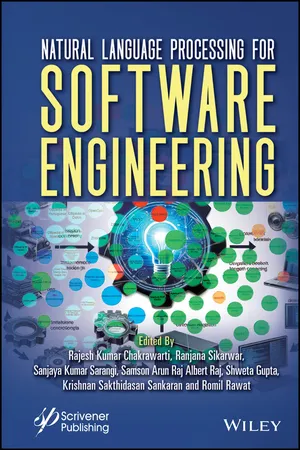
Natural Language Processing for Software Engineering
- 544 pages
- English
- PDF
- Available on iOS & Android
Natural Language Processing for Software Engineering
About this book
Discover how Natural Language Processing for Software Engineering can transform your understanding of agile development, equipping you with essential tools and insights to enhance software quality and responsiveness in today's rapidly changing technological landscape.
Agile development enhances business responsiveness through continuous software delivery, emphasizing iterative methodologies that produce incremental, usable software. Working software is the main measure of progress, and ongoing customer collaboration is essential. Approaches like Scrum, eXtreme Programming (XP), and Crystal share these principles but differ in focus: Scrum reduces documentation, XP improves software quality and adaptability to changing requirements, and Crystal emphasizes people and interactions while retaining key artifacts. Modifying software systems designed with Object-Oriented Analysis and Design can be costly and time-consuming in rapidly changing environments requiring frequent updates. This book explores how natural language processing can enhance agile methodologies, particularly in requirements engineering. It introduces tools that help developers create, organize, and update documentation throughout the agile project process.
Frequently asked questions
- Essential is ideal for learners and professionals who enjoy exploring a wide range of subjects. Access the Essential Library with 800,000+ trusted titles and best-sellers across business, personal growth, and the humanities. Includes unlimited reading time and Standard Read Aloud voice.
- Complete: Perfect for advanced learners and researchers needing full, unrestricted access. Unlock 1.4M+ books across hundreds of subjects, including academic and specialized titles. The Complete Plan also includes advanced features like Premium Read Aloud and Research Assistant.
Please note we cannot support devices running on iOS 13 and Android 7 or earlier. Learn more about using the app.
Information
Table of contents
- Cover
- Series Page
- Title Page
- Copyright Page
- Contents
- Preface
- Chapter 1 Machine Learning and Artificial Intelligence for Detecting Cyber Security Threats in IoT Environmment
- Chapter 2 Frequent Pattern Mining Using Artificial Intelligence and Machine Learning
- Chapter 3 Classification and Detection of Prostate Cancer Using Machine Learning Techniques
- Chapter 4 NLP-Based Spellchecker and Grammar Checker for Indic Languages
- Chapter 5 Identification of Gujarati Ghazal Chanda with Cross-Platform Application
- Chapter 6 Cancer Classification and Detection Using Machine Learning Techniques
- Chapter 7 Text Mining Techniques and Natural Language Processing
- Chapter 8 An Investigation of Techniques to Encounter Security Issues Related to Mobile Applications
- Chapter 9 Machine Learning for Sentiment Analysis Using Social Media Scrapped Data
- Chapter 10 Opinion Mining Using Classification Techniques on Electronic Media Data
- Chapter 11 Spam Content Filtering in Online Social Networks
- Chapter 12 An Investigation of Various Techniques to Improve Cyber Security
- Chapter 13 Brain Tumor Classification and Detection Using Machine Learning by Analyzing MRI Images
- Chapter 14 Optimized Machine Learning Techniques for Software Fault Prediction
- Chapter 15 Pancreatic Cancer Detection Using Machine Learning and Image Processing
- Chapter 16 An Investigation of Various Text Mining Techniques
- Chapter 17 Automated Query Processing Using Natural Language Processing
- Chapter 18 Data Mining Techniques for Web Usage Mining
- Chapter 19 Natural Language Processing Using Soft Computing
- Chapter 20 Sentiment Analysis Using Natural Language Processing
- Chapter 21 Web Data Mining: Exploring Hyperlinks, Contents, and Usage Data
- Chapter 22 Intelligent Pattern Discovery Using Web Data Mining
- Chapter 23 A Review of Security Features in Prominent Cloud Service Providers
- Chapter 24 Prioritization of Security Vulnerabilities under Cloud Infrastructure Using AHP
- Chapter 25 Cloud Computing Security Through Detection & Mitigation of Zero-Day Attack Using Machine Learning Techniques
- Chapter 26 Predicting Rumors Spread Using Textual and Social Context in Propagation Graph with Graph Neural Network
- Chapter 27 Implications, Opportunities, and Challenges of Blockchain in Natural Language Processing
- Chapter 28 Emotion Detection Using Natural Language Processing by Text Classification
- Chapter 29 Alzheimer Disease Detection Using Machine Learning Techniques
- Chapter 30 Netnographic Literature Review and Research Methodology for Maritime Business and Potential Cyber Threats
- Chapter 31 Review of Research Methodology and IT for Business and Threat Management
- About the Editors
- Index
- Also of Interest
- EULA